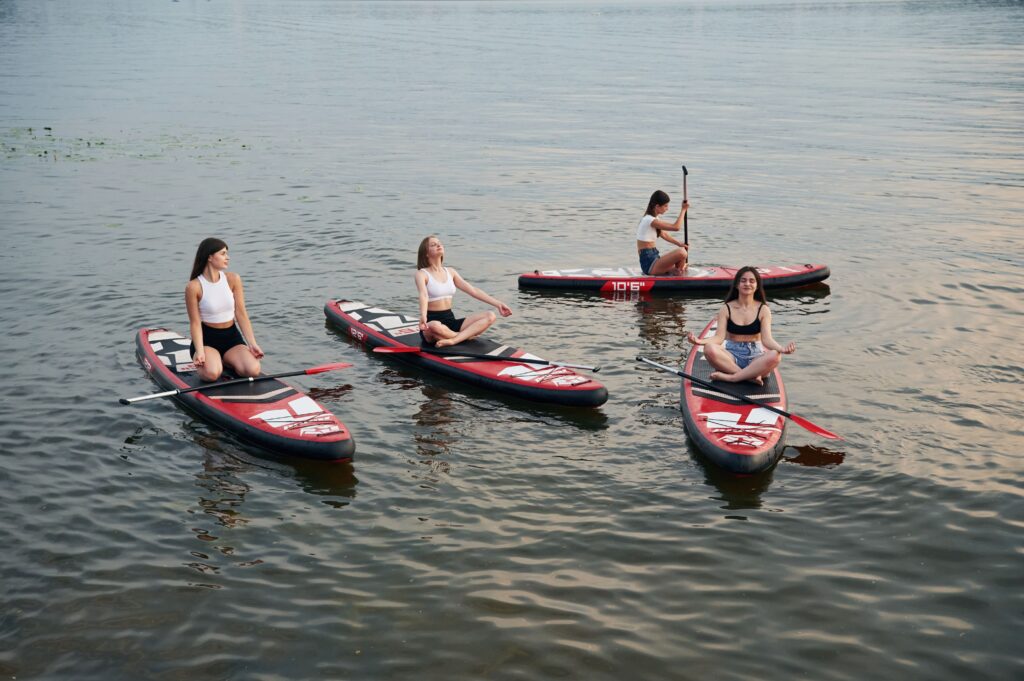Introduction to SUP
Stand-Up Paddleboarding (SUP) has swiftly gained popularity across the globe, drawing enthusiasts to its unique blend of tranquility and physical exertion. Originating in the Hawaiian Islands, SUP traces its roots back to the ancient Polynesian cultures, where standing on boards while paddling was a common practice. Modern SUP, however, began to take shape in the 20th century, evolving from traditional surfing practices and incorporating the use of a paddle for propulsion.
The essential equipment for SUP is relatively straightforward, making it accessible to a wide audience. The primary components include a paddleboard, a paddle, and a personal flotation device (PFD). Paddleboards come in various shapes and sizes, catering to different skill levels and intended activities, such as leisure paddling, racing, or even yoga. Paddles are typically adjustable to suit the height of the paddler, ensuring comfort and efficiency during use. Safety is paramount, and wearing a PFD is often recommended, especially for beginners or when paddling in deeper waters.
One of the main reasons for SUP’s growing popularity is its low-impact nature, making it suitable for individuals of all ages and fitness levels. Unlike high-impact sports that can strain joints and muscles, stand-up paddleboarding offers a gentle yet effective workout, promoting cardiovascular health, core strength, and balance. Beginners can easily grasp the basics with a short lesson or two, while the serene environment of water bodies provides a calming backdrop that enhances the overall experience.
Furthermore, SUP’s versatility as an activity means it can be enjoyed solo or as a social endeavor, traversing calm lakes, rivers, or even the ocean. Its accessibility and the minimal learning curve have contributed to its widespread adoption, encouraging more people to engage in this harmonious blend of physical activity and mental relaxation. Whether seeking a peaceful escape or a dynamic workout, stand-up paddleboarding offers an inviting avenue for holistic wellness.
Physical Health Benefits of SUP

Stand-up paddleboarding (SUP) is not just a leisurely activity; it provides a comprehensive full-body workout that can significantly enhance physical health. One of the primary benefits of SUP is its ability to engage multiple muscle groups simultaneously. When paddleboarding, individuals use their core muscles, including the abdominals and obliques, to maintain balance and stability on the board. The action of paddling targets the arms, shoulders, and upper back, while the legs work continuously to keep the body steady and aligned, making SUP an effective workout for the entire body.
Beyond muscle engagement, stand-up paddleboarding offers substantial cardiovascular benefits. The combination of paddling and balancing increases heart rate, promoting cardiovascular endurance and improving overall heart health. Regular participation in SUP can lead to enhanced aerobic capacity, making everyday activities easier and more enjoyable.
Improved balance and flexibility are additional physical health benefits of SUP. The constant need to adjust and stabilize on the board requires keen proprioception and coordination, which over time, can lead to better balance and reduced risk of falls. The dynamic movements involved in paddling and maneuvering the board also contribute to increased flexibility, particularly in the hips, shoulders, and ankles.
One of the standout features of stand-up paddleboarding is its low-impact nature. Unlike high-impact sports that can strain the joints and lead to injuries, SUP provides a gentle yet effective workout. This makes it an ideal option for individuals undergoing injury rehabilitation or those looking to prevent injuries. The buoyancy of the water supports the body, reducing stress on the joints while still providing enough resistance to build strength and endurance.
Testimonials from SUP enthusiasts often highlight these physical health benefits. For instance, Jane, an avid paddleboarder, shares, “Since I started SUP, I’ve noticed a significant improvement in my core strength and overall fitness. It’s a fun and effective way to stay in shape without putting too much stress on my body.”
Incorporating stand-up paddleboarding into one’s fitness routine can lead to a healthier, more balanced body, making it a worthwhile activity for individuals of all ages and fitness levels.
Mental Health Benefits of SUP
Stand-up paddleboarding (SUP) offers a multitude of mental health benefits that can significantly improve one’s overall well-being. Engaging in SUP allows individuals to experience the calming effect of being out on the water, which is known to reduce stress, anxiety, and depression. The rhythmic motion of paddling can induce a meditative state, helping to clear the mind and promote a sense of peace and relaxation.

Scientific studies have shown that spending time in nature can greatly enhance mood and mental clarity. The natural surroundings encountered during a paddleboarding session, such as serene lakes, rivers, and coastal waters, provide a tranquil environment that fosters mental rejuvenation. The combination of physical activity and nature immersion helps release endorphins, the body’s natural mood elevators, contributing to an overall sense of well-being.
Moreover, the meditative aspects of SUP cannot be overstated. The concentration required to balance on the board and the rhythmic, repetitive motion of paddling can serve as a form of moving meditation. This practice helps to focus the mind, reduce mental clutter, and improve mindfulness, which are all essential components for managing stress and anxiety.
Another significant mental health benefit of paddleboarding is the sense of accomplishment and confidence that comes from mastering the sport. Learning to balance and navigate on the board can be challenging, but with practice, individuals often experience a boost in self-esteem and confidence. Personal anecdotes from paddleboarders frequently highlight the joy and satisfaction derived from overcoming initial difficulties and achieving proficiency in the sport.
In essence, stand-up paddleboarding offers a holistic approach to improving mental health. The combination of physical exercise, natural beauty, and meditative practice creates a powerful tool for enhancing mental well-being. Whether through scientific evidence or personal experiences, the mental health benefits of SUP are undeniable and accessible to anyone willing to take up the paddle.
Experiencing SUP in the Algarve

The Algarve, located in the southernmost region of Portugal, offers a unique and captivating environment for stand-up paddleboarding (SUP) enthusiasts. This area is renowned for its stunning landscapes, featuring dramatic cliffs, golden beaches, and tranquil caves. The Algarve’s crystal-clear waters and favorable climate make it an ideal destination for both beginners and seasoned paddlers alike.
One of the most appealing aspects of SUP in the Algarve is the opportunity to explore hidden gems that are otherwise inaccessible. The region’s calm waters are perfect for gliding along the coast, allowing paddlers to discover secluded beaches and picturesque coves. Some of the most popular spots include Praia da Marinha, known for its iconic rock formations, and the stunning Benagil Cave, which can only be accessed by water.
For those new to stand-up paddleboarding, the Algarve offers numerous rental shops and guided tours to help you get started. Local businesses such as Algarve SUP and Blue Xperiences provide equipment rental and expert instruction, ensuring a safe and enjoyable experience on the water. Guided tours, often led by knowledgeable locals, offer a great way to learn about the area’s rich marine life and coastal history while honing your paddling skills.
In addition to its natural beauty, the Algarve’s climate is another significant draw for SUP enthusiasts. With over 300 days of sunshine each year and mild temperatures, the region provides optimal conditions for paddleboarding nearly year-round. Early mornings and late afternoons are particularly favorable times to hit the water, as the gentle breeze and soft light create a serene and peaceful atmosphere.
Many paddlers who have experienced SUP in the Algarve often share their stories of awe and wonder. From witnessing the vibrant marine life beneath the surface to enjoying the breathtaking sunsets over the Atlantic, stand-up paddleboarding in this region offers a truly memorable adventure. Whether you’re seeking a tranquil escape or an exhilarating challenge, the Algarve’s stunning landscapes and welcoming waters provide the perfect backdrop for your SUP journey.






